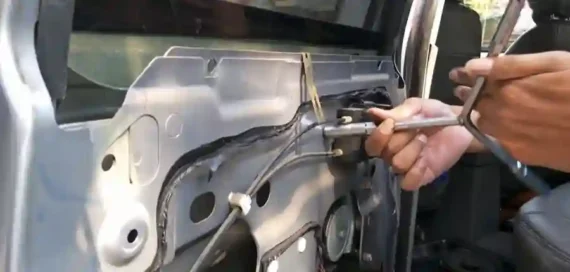Your car’s window regulator plays a vital role in ensuring that your windows operate smoothly and reliably. Over time, the moving parts of the window regulator can wear down and become subject to friction and corrosion. To prolong the life of your window regulator and maintain its proper function, lubrication is essential. However, choosing the right lubricant can be a bit daunting with the variety of options available. In this article, we’ll guide you through the process of selecting the right window regulator lubricant to keep your car’s windows in excellent working condition.
Understanding Window Regulator Lubrication:
Before we delve into the selection process, let’s briefly understand why lubricating your window regulator is necessary.
A window regulator is a mechanical or electrical device in your vehicle that controls the movement of the windows. It ensures that you can raise or lower the windows with ease, providing ventilation, visibility, and access to fresh air. The regulator consists of various moving parts, such as gears, cables, and tracks. Over time, these parts can experience wear and tear, leading to increased friction and the potential for damage.
Lubrication serves several essential purposes for window regulators:
- Reducing Friction: Lubricants create a protective barrier between moving parts, reducing friction. This minimizes wear and tear and ensures smooth operation.
- Preventing Corrosion: Window regulators are exposed to the elements, and moisture can lead to corrosion. Lubricants with corrosion-resistant properties help protect the components.
- Maintaining Quiet Operation: Properly lubricated window regulators operate quietly, without the squeaks and noises that can occur when parts rub against each other.
- Extending Lifespan: Regular lubrication can extend the lifespan of your window regulator, potentially saving you from costly repairs or replacements.
Choosing the Right Window Regulator Lubricant:
When selecting a lubricant for your window regulator, consider the following factors to ensure you make the best choice:
- Compatibility with Materials: The lubricant you choose should be compatible with the materials used in your window regulator’s construction. Most window regulators contain plastic, metal, and rubber components. Ensure that the lubricant won’t damage or degrade these materials.
- Temperature Range: Consider the temperature range in which your vehicle operates. Some lubricants are designed to withstand extreme temperatures, making them suitable for use in both hot summers and cold winters.
- Corrosion Protection: Look for a lubricant that offers corrosion protection. This is especially important if you live in an area with high humidity or where road salt is used during the winter.
- Viscosity: Viscosity refers to the thickness or consistency of the lubricant. For window regulators, a medium viscosity lubricant is generally a good choice. It should be thick enough to provide adequate protection but not so thick that it gums up the moving parts.
- Longevity: Some lubricants are formulated to provide long-lasting protection, reducing the frequency of reapplication. Consider how often you’re willing to re-lubricate your window regulator when choosing a product.
- Water Resistance: Given that window regulators are exposed to the elements, a water-resistant or waterproof lubricant is beneficial. This helps prevent moisture from causing corrosion or interfering with smooth operation.
- Ease of Application: Consider how easy it is to apply the lubricant. Some products come in convenient spray cans, while others require more intricate application methods.
- Compatibility with Lubrication Points: Take note of the various lubrication points on your window regulator. Ensure that the chosen lubricant can reach these areas effectively.
Common Types of Lubricants for Window Regulators:
Several types of lubricants are suitable for window regulators. Here are some of the most common options:
- White Lithium Grease: White lithium grease is a versatile lubricant that offers excellent protection against wear, corrosion, and moisture. It has a medium viscosity and is suitable for most window regulators.
- Silicone Spray Lubricant: Silicone spray lubricants are known for their water-resistant properties. They create a protective film that repels moisture and provides long-lasting lubrication. Silicone spray is easy to apply and won’t attract dust or dirt.
- Graphite Lubricant: Graphite lubricants are often used for locks and hinges, but they can also be suitable for window regulators. They provide dry lubrication, which can be advantageous in preventing dust and dirt buildup.
- Teflon-Based Lubricant: Teflon-based lubricants offer a smooth, low-friction coating that reduces wear and ensures quiet operation. They are also known for their resistance to extreme temperatures.
- Multipurpose Penetrating Oils: Some multipurpose penetrating oils like WD-40 have lubricating properties and can be used on window regulators. However, they may require more frequent reapplication compared to specialized lubricants.
Application Tips:
Once you’ve selected the right lubricant for your window regulator, here are some tips for effective application:
- Clean the Regulator: Before applying lubricant, clean the window regulator components to remove dirt, dust, and old lubricant residue. A clean surface allows the lubricant to adhere better and work more effectively.
- Use a Small Applicator: For precise application, consider using a small brush or a straw attachment on a spray can to reach tight spots on the regulator.
- Apply Sparingly: Avoid over-applying lubricant, as excess lubrication can attract dirt and debris, potentially causing more harm than good.
- Work the Mechanism: After applying the lubricant, work the window regulator by raising and lowering the window a few times to distribute the lubricant evenly.
- Regular Maintenance: Make window regulator lubrication part of your regular maintenance routine, especially if you live in an area with extreme weather conditions.
Conclusion:
Properly lubricating your car’s window regulator is a simple yet crucial maintenance task that can extend the life of this essential component and ensure the smooth operation of your vehicle’s windows. By selecting the right lubricant and following proper application techniques, you can keep your window regulator in excellent condition, reducing the risk of wear, corrosion, and unexpected malfunctions. Regular maintenance not only saves you money on repairs but also ensures your windows operate smoothly and quietly, enhancing your overall driving experience.




